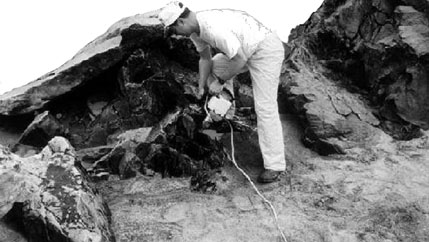
 |
|
|
Seismology
gives more history to cratonic roots
 |
| Rick
Carlson of the Carnegie Institution of Washington drills samples from the
komalites of the Nondweni greenstone belt exposed here in the Vumankala
River valley in Kwa-Zulu Natal.
Allan Wilson, University of Natal in Durban, South Africa. |
But geochemical and petrological studies of these xenoliths are not the only means of producing answers. Information gained from new seismic experiments, in combination with previous results, is providing a comprehensive report on craton formation. The goal of the Southern Africa Seismic Experiment is to study the deep structure of the tectosphere, including craton roots, which is part of the larger Kaapvaal Project.
That project includes the Carnegie Institution of Washington and the Massachusetts Institute of Technology, along with many collaborating universities and exploration companies in Africa.
“The primary concern is to understand the processes that formed the very first enduring continental masses and to understand how these continental masses have survived 3 billion years of active mantle convection,” says seismologist David James of the Department of Terrestrial Magnetism at the Carnegie Institution.
One result from seismic studies indicates that deep contacts between geologic terrane boundaries are vertical or nearly vertical. “Vertical contacts are important because it means that the roots are neither spreading out beneath the adjacent younger provinces nor tapering dramatically with depth, as might be expected if they were being eroded away,” James says.
Scientists believe that roots are still intact even after 3 billion years because they are less dense and stronger than the mantle. “But according to many current models they should not be there at all, having been eroded away long ago by convection in the mantle,” James says.
“Why they haven’t been is a fundamental scientific problem and a clue to both the processes that formed them and the dynamical processes that have gone on in the mantle since.”
Julia Cole
Geotimes contributing
writer